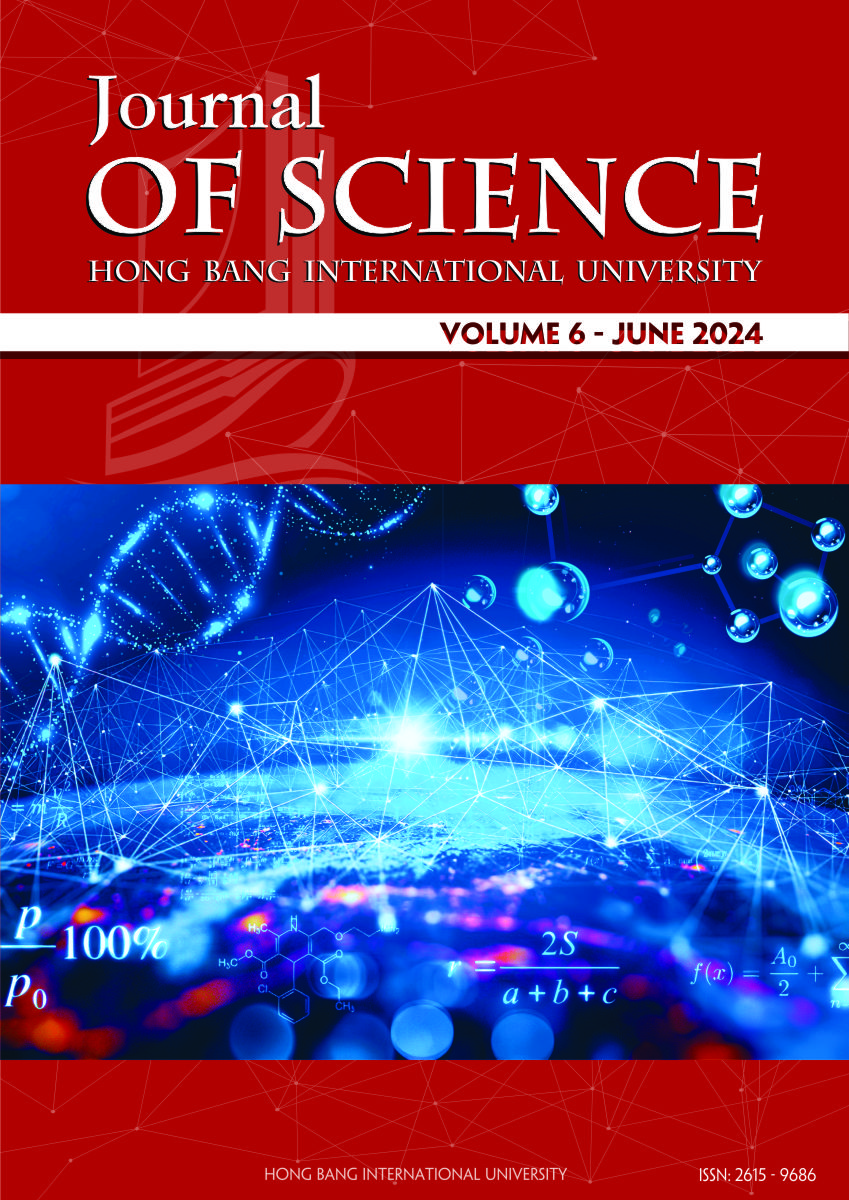Evaluation of in silico anticancer activity of bioactive compounds of black ginger as VEGFR2 inhibitors
Các tác giả
DOI: https://doi.org/10.59294/HIUJS.VOL.6.2024.626Từ khóa:
gừng đen, kháng ung thư, in silico, docking phân tử, VEGFR2Abstract
The main components of black ginger (Kaempferia parviflora Wall ex Baker.) show diverse biological effects, especially potential anticancer activity. Thirty-five bioactive compounds were screened for anticancer activity by molecular docking with AutoDock Vina software on VEGFR2 kinase. Five bioactive compounds of black ginger showed the strongest interaction with VEGFR2 target, especially stronger than the reference drug Axitinib (-9.2 Kcal/mol) including 5-Hydroxy-7,4'-dimethoxyflavanone (-9.9 Kcal/mol), Kaempferide (-9.7 Kcal/mol), 5-Hydroxy-7-methoxyflavone (-9.6 Kcal/mol), Genkwanin (-9.6 Kcal/mol), and Sakuranetin (-9.5 Kcal/mol). Kaempferide formed the most hydrogen bonds on VEGFR2 kinase with four strong hydrogen bonds (1.76-2.86 Å) and one carbon-hydrogen bond (3.78 Å). The hydrogen bonds are formed at the hydroxy (-OH) and methoxy (-OCH3) groups of these phytocompounds. In particular, these bioactive compounds all demonstrated hydrogen bond formation, hydrogen bond length, and hydrophobic interactions at levels equal to or better than the reference drug Axitinib. Therefore, these compounds could be potential molecules to develop new anticancer drugs on the VEGFR2 target.
Tài liệu tham khảo
[1] S. Saokaew, P. Wilairat, P. Raktanyakan, P. Dilokthornsakul, T. Dhippayom, C. Kongkaew, R. Sruamsiri, A. Chuthaputti, N. Chaiyakunapruk, “Clinical effects of Krachaidum (Kaempferia parviflora): a systematic review,” J Evid Based Complementary Altern Med., vol 22, pp. 413-428, 2017. DOI: 10.1177/2156587216669628.
DOI: https://doi.org/10.1177/2156587216669628[2] I. Hairunisa, M. F. A. Bakar, M. Da'i, F. I. A. Bakar and E. S. Syamsul, “Cytotoxic activity, anti-migration and in silico study of black ginger (Kaempferia parviflora) extract against breast cancer cell,” Cancers (Basel), vol. 15, p. 2785, 2023. DOI: 10.3390/cancers15102785.
[3] C. Yenjai, K. Prasanphen, S. Daodee, V. Wongpanich, P. Kittakoop, “Bioactive flavonoids from Kaempferia parviflora,” Fitoterapia, vol 75, p. 89e92, 2004. DOI: 10.1016/j.fitote.2003.08.017.
DOI: https://doi.org/10.1016/j.fitote.2003.08.017[4] P. C. Em and N. T. Tuyen, “Design, microwave-assisted synthesis, antimicrobial and anticancer evaluation, and in silico studies of some 2-naphthamide derivatives as DHFR and VEGFR-2 Inhibitors,” ACS Omega., vol. 7(37), pp. 33614-33628, 2022. DOI: 10.1021/acsomega.2c05206.
DOI: https://doi.org/10.1021/acsomega.2c05206[5] S. Paramee, S. Sookkhee, C. Sakonwasun, M. Na Takuathung, P. Mungkornasawakul, W. Nimlamool and S. Potikanond, “Anti-cancer effects of Kaempferia parviflora on ovarian cancer SKOV3 cells,” BMC Complement Altern Med., vol. 18, p. 178, 2018. DOI: 10.1186/s12906-018-2241-6.
DOI: https://doi.org/10.1186/s12906-018-2241-6[6] S. Potikanond, S. Sookkhee, M. Na Takuathung, P. Mungkornasawakul, N. Wikan, D. R. Smith, W. Nimlamool, “Kaempferia parviflora extract exhibits anti-cancer activity against HeLa cervical cancer cells,” Front Pharmacol., vol. 8, p. 630, 2017. DOI: 10.3389/fphar.2017.00630.
DOI: https://doi.org/10.3389/fphar.2017.00630[7] P. C. Em, L. T. Tuong Vi and N. T. Tuyen, “Design, synthesis, bio-evaluation, and in silico studies of some N-substituted 6-(chloro/nitro)-1H-benzimidazole derivatives as antimicrobial and anticancer agents,” RSC Adv., vol. 12(33), pp. 21621-21646, 2022. DOI: 10.1039/d2ra03491c.
DOI: https://doi.org/10.1039/D2RA03491C[8] P. C. Em, N. T. Tuyen, N. D. Hanh Nguyen, V. D. Duy and D. T. Hong Tuoi, “Synthesis of a series of novel 2-amino-5-substituted 1,3,4-oxadiazole and 1,3,4-thiadiazole derivatives as potential anticancer, antifungal and antibacterial agents”, Med. Chem., vol. 18, pp. 558-573, 2022. DOI: 10.2174/1573406417666210803170637.
DOI: https://doi.org/10.2174/1573406417666210803170637[9] P. C. Em, L. T. Tuong Vi, T. P. Long, T. N. Huong-Giang, N. L. Bao Khanh and N. T. Tuyen, “Design, synthesis, antimicrobial evaluations and in silico studies of novel pyrazol-5(4H)-one and 1H-pyrazol-5-ol derivatives,” Arab. J. Chem., vol. 15(3), p. 103682, 2022. DOI: 10.1016/j.arabjc.2021.103682.
DOI: https://doi.org/10.1016/j.arabjc.2021.103682[10] P. C. Em, L. T. Tuong Vi, L. H. Huong Ha, V. T. Bich Ngoc, B. V. Long, V. T. Thao, D. V. Duy, T. N. Ngoc Vi, N. L. Bao Khanh and N. T. Tuyen, “N,2,6-Trisubstituted 1H-benzimidazole derivatives as a new scaffold of antimicrobial and anticancer agents: Design, synthesis, in vitro evaluation, and in silico studies,” RSC Adv., vol. 13(1), pp. 399-420, 2023. DOI: 10.1039/d2ra06667j.
DOI: https://doi.org/10.1039/D2RA06667J[11] I. Hairunisa, M. F. A. Bakar, M. Da'i, F. I. A. Bakar and E. S. Syamsul, “Cytotoxic activity, anti-migration and in silico study of black ginger (Kaempferia parviflora) extract against breast cancer cell,” Cancers (Basel)., vol. 15, p. 2785, 2023. DOI: 10.3390/cancers15102785.
DOI: https://doi.org/10.3390/cancers15102785Tải xuống
Tải xuống: 128











